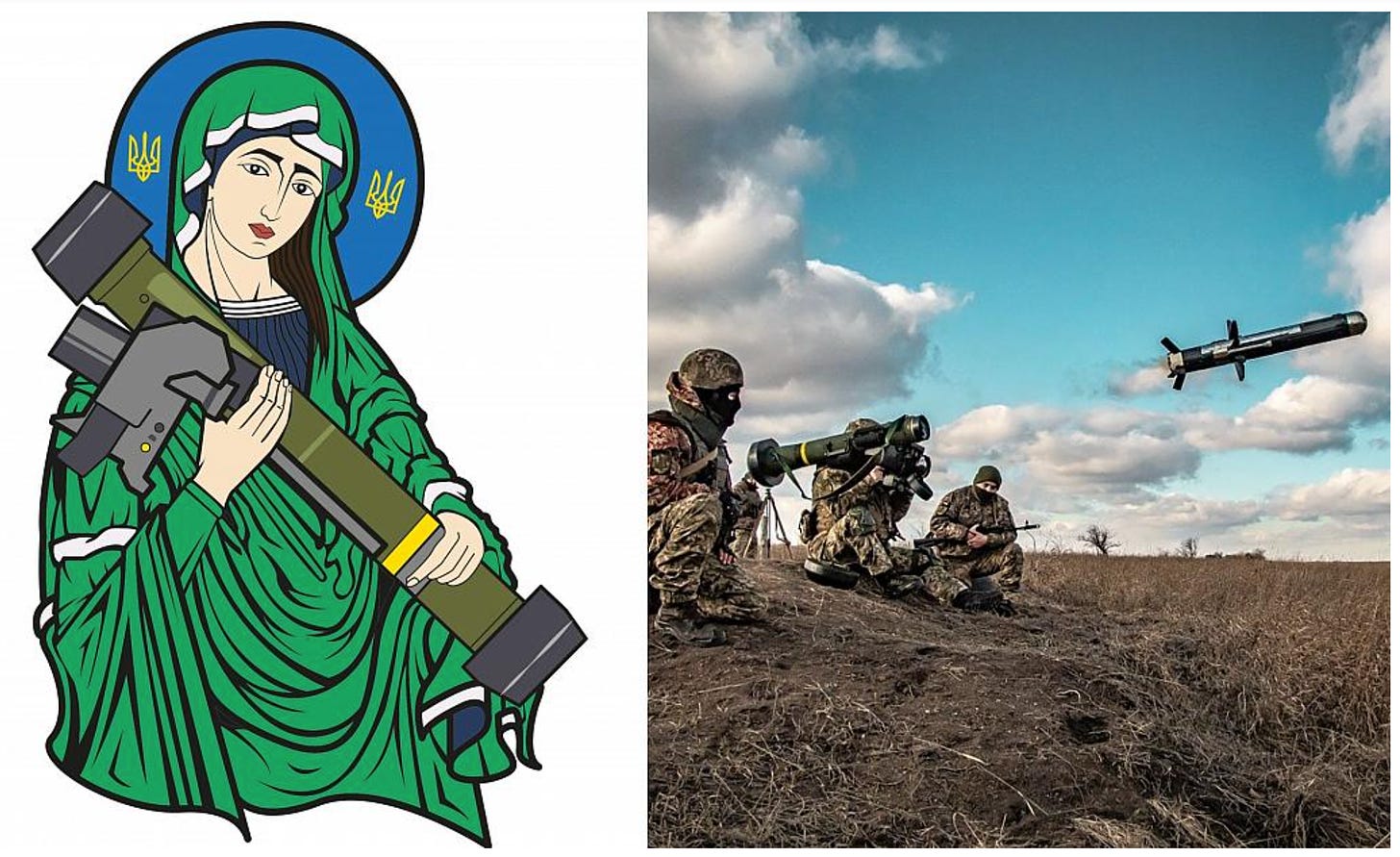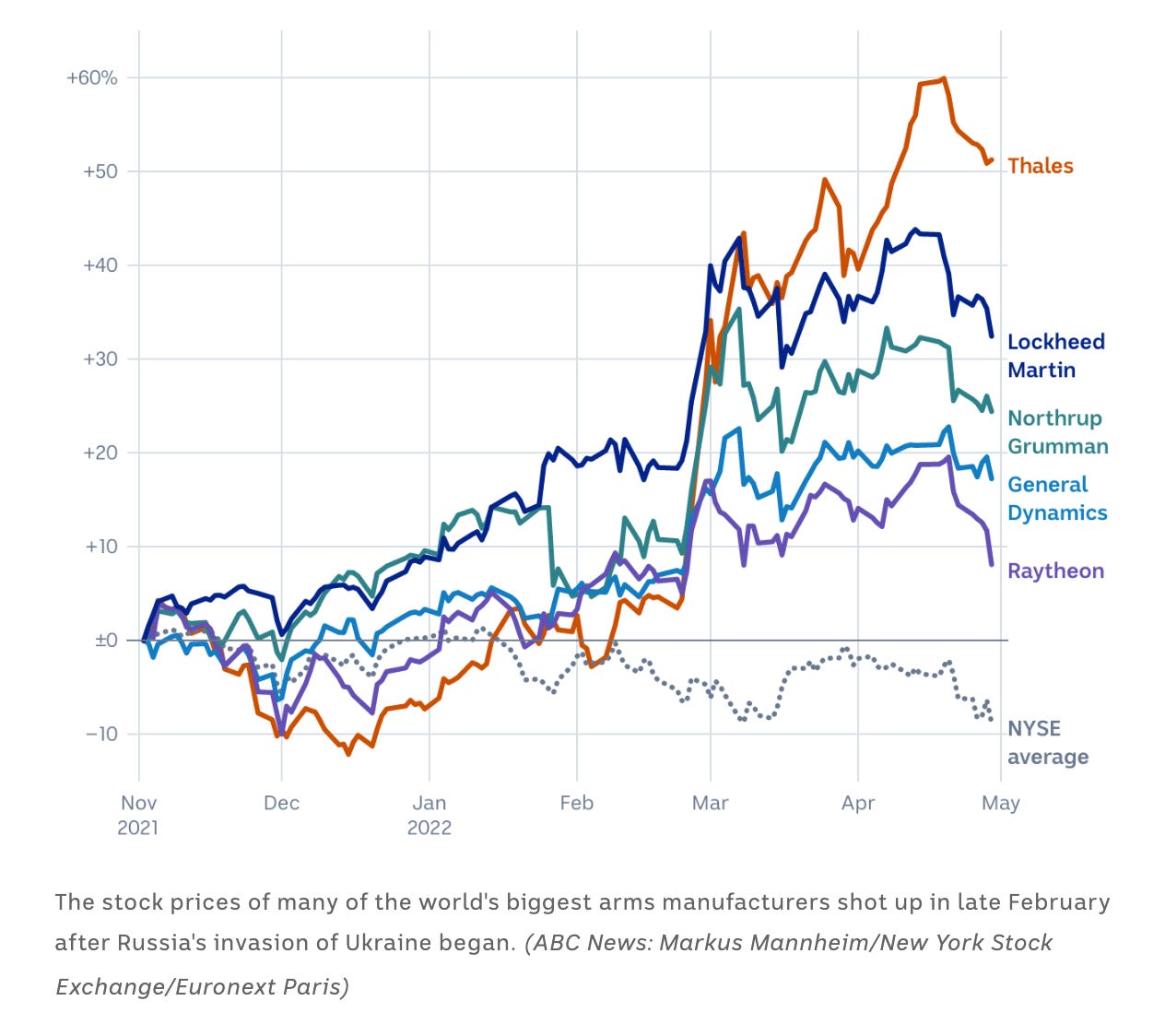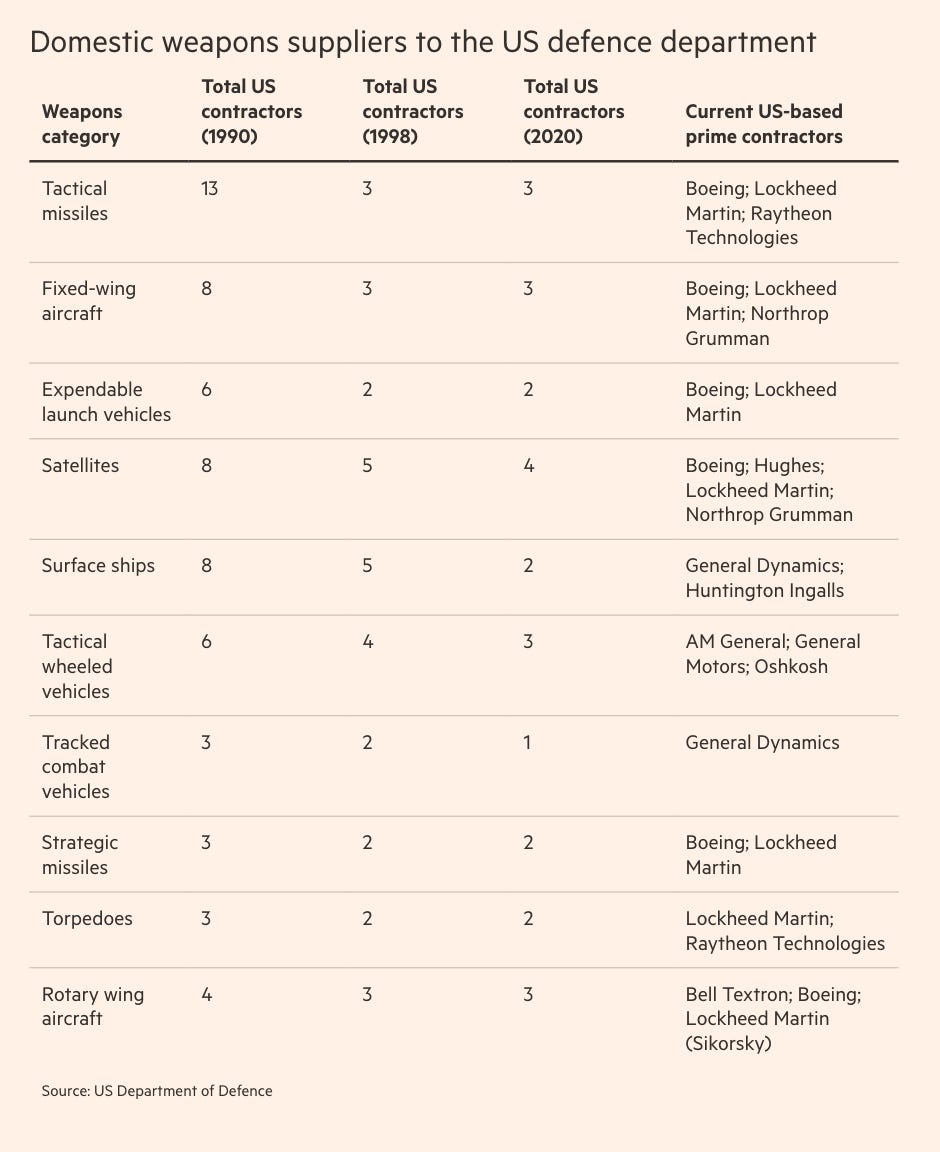If there is a weapon that symbolizes the war in Ukraine, it is the FGM-148 anti-tank infrared guided missile also known as Javelin. Images of St Javelin which shows Mary Magdalene holding a Javelin launcher in the style of an Eastern Orthodox church painting have become memes. Sticker and merchandise sales from the official site have raised over $800k for Ukraine’s resistance.

The portable, highly accurate Javeline missile allows small teams of infantry to take on armored columns at ranges of up to 4 kilometers. It fits perfectly with the David and Goliath narrative of the war in Ukraine, on which more in a future Chartbook.
Miraculous though it may seem, the Javelin is not a gift from god. Its development goes back to the early 1980s when the US Army specified its requirement for an Advanced Anti-Tank Weapon System. Initial exploratory research work was done by Ford Aerospace (laser-beam riding), Hughes Aircraft Missile System Group (imaging infrared combined with a fiber-optic cable link) and Texas Instruments (imaging infrared). Full-scale development began in 1989 as a joint venture between Texas Instruments and Martin Marietta, with production beginning in 1994 and deployment in 1996. It is now the property of Raytheon and Lockheed Martin.
If the Javelin missile on the battlefield today has a mother it is not a faux orthodox Saint, but Linda Griffin, a Senior Assembler at Lockheed Martin’s missile plant in the county seat of Troy, Alabama.
With family in the military, Linda and the Javelin anti-tank missile team fully recognize how critical this work is. https://t.co/jBS4FKY6Qd pic.twitter.com/E9HEgEN5QW
— Lockheed Martin (@LockheedMartin) May 3, 2022
Lockheed’s Troy plant is not large. All told it employs around 600 direct and contractor staff, of which 265 support Javelin production.
Over the last 25 years Ms Griffin’s has personally handled every one of the 50,000 Javelins produced by Lockheed in Troy. She made that proud boast in the course of a corporate reception for President Biden on a recent tour of the plant.
This week, we were proud to show @POTUS the Javelin anti-tank missile final assembly line and how we are on a mission to support our customers and allies in mission success. pic.twitter.com/YVT48ZssLb
— Lockheed Martin (@LockheedMartin) May 6, 2022
Everyone loves the Javeline. Visiting the factory Biden had a message that fitted right in with his promise of a foreign policy for the American middle class.
“Being the arsenal of democracy also means good-paying jobs for American workers in Alabama, in the states all across America, where defense equipment is manufactured and assembled,” Mr. Biden said Tuesday.
So far the Biden administration has delivered 5500 Javelin missiles to Ukraine from its stockpiles. That accounts for about a quarter of the extant stock in the US. What America aims to do now is to raise production from its current level of c. 2000 per annum to a maximum capacity of 6,000 per year. The question is how fast that can be done.
The problem is that the missiles each contain about 250 microchips which are in short supply. And labour is scarce too. Lockheed opened its plant in Troy in 1994. As Doug Cameron reports for the WSJ
Companies such as Lockheed tend to locate facilities producing munitions in more remote areas, in part because of the hazard associated with sensitive materials, which has also historically helped keep costs down. … .
As Jim Taiclet, CEO of Lockheed told an event last year: “The good thing about where our locations tend to be is they’re not necessarily in Palo Alto, for example, where there’s direct competition.”
The Javlin is a late product of what Ann Markusen et al famously called the “Gunbelt”, a remapping of the US economy produced by the military-industrial complex. From World War II onwards, jobs were relocated from the industrialized and unionized North to the low-wage South. CEO Taiclet is right. Pike county Alabama, of which Troy is the capital, is not Palo Alto.
The median income for a household in the county was $25,551 …. Males had a median income of $27,094 versus $18,758 for females. The per capita income for the county was $14,904. About 18.50% of families and 23.10% of the population were below the poverty line, including 29.90% of those under age 18 and 21.90% of those age 65 or over.
America’s military hardware may have arrived on the Ukrainian battlefield like a miracle, but in per capita income terms the gap between the production site of the Javelin missile in Alabama and Eastern Europe is not as wide as you might imagine.
As Doug Cameron reports, times are good in Troy. The unemployment rate fell to 2.4% in March 2022, half the level four years earlier. Lockheed is due to host its latest job fair at Kennesaw State University near its facility in Marietta, Ga.
On the eve of Russia’s invasion of Ukraine and amid a national labor shortage, Lockheed was offering to pay $16 to $20 an hour for trainee assembly workers at the plant, and a $1,500 signing bonus for college graduates with the security clearance required for many of the positions …. The company currently lists 26 vacancies at the Troy plant, including missile assemblers, quality supervisors and engineers.
Lockheed fells the urgency of the moment.
Jim Taiclet, Lockheed’s chief executive, said that though it has been awaiting contracts for fresh Javelin production, it was prepared to invest in hiring, tooling and potential supplier support.“For something this urgent, we’re going to go ahead and invest in it ahead of need,”
“I went over to the Pentagon with my team and basically told the senior leadership there, ‘Look, we’re already investing in increasing the capacity, please make it right and give us the contracts and agreements we need down the road, but we’re going to start investing now,’” he was quoted as saying by Inside Defense.
“Please make it right!” is quite the phrase. According to multiple reports, Taiclet and other defense industrial CEOs have been in regular meetings with the Pentagon to ramp up production.
At the start of the year the sales of America’s contractors were declining under the impact of supply shortages. But since February 2022 the story has turned. On earnings calls Lockheed Martin, Raytheon Technologies, Boeing, Northrop Grumman and General Dynamics — prime contractors for the US Department of Defense — have all acknowledged the surge of business coming their way. Their stocks are bucking an otherwise bearish market.

Worldwide, in 2021 global defence spending topped $2tn for the first time, according to the Stockholm International Peace Research Institute.

The war in Ukraine has put the focus on land weapons systems, but the really big ticket items in naval and aerospace will be driven by mounting tension between West and China. Defense consultants affect a professional, somber tone, but in truth they can hardly disguise their glee. As one remarked to the FT.
“The depressing reality is that the last 30 years of [relative peacetime] might just be an aberration,” said Richard Aboulafia, an aerospace consultant at AeroDynamic Advisory. “[People thought:] ‘We won the cold war. Now, that’s the end of naked human aggression — excellent — let’s go start a unicorn petting zoo and everything will be fine.’ And it didn’t work.”
Now is a moment for defense industrial lobbyists to demand investment in a sector, which has changed dramatically since the end of the Cold War. In the early 1990s the Pentagon worked with 51 prime defense contractors. Today it deals with five diversified corporations, of which Lockheed is, by some margin, the largest.

In 2020, defense contracts accounted for 58 per cent of Pentagon spending, the highest level in 20 years, according to CSIS. Of the $421bn doled out in contracts that year, 36 per cent went to the Big Five contractors, up from 19 per cent in 1990.
In the arguments of lobby groups like the National Defense Industrial Association macroeconomics and oligopolistic special pleading go hand in hand.
The trade group has warned about the combination of worker shortages and supply chain kinks…. “A surge of new demand when there is a positive output gap would likely result in production shortages, price inflation and a lack of investment in new productive capacity,” it said in a January report on the defense industrial base.
The jostling for position within the industry is full of intrigues that play out up and down the supply chain.
The two key contractors for the Javelin are Lockheed and Raytheon Technologies Corp., which makes the famous fire and forget missile control system in Tucson, Ariz. As far as the Javelin is concerned, Lockheed and Raytheon seem to rub along amicably enough. The same cannot be said for the solid fuel rocket which after an initial soft launch, ignites at a safe distance from the tank hunters and propels the missile to its target thousands of meters away.
In 1990 the US had eight manufacturers of rocket motors. Now it has two. For the Javelin the key supplier is Aerojet Rocketdyne, of El Segundo California. After Northrup Grumman bought its lone rival Orbital ATK Inc. in 2018. Rocketdyne is now the only independent producer of rocket motors.

Unsurprisingly, given Northrop’s move, Lockheed was until early in 2022 maneuvering to snap up Aerojet for $4.4 billion. It was blocked by the Federal Trade Commission on antitrust grounds. Even the Pentagon is concerned about the degree of consolidation in the rocket motor sector.
The collapse of the Lockheed takeover has triggered a knock down drag out fight within Aerojet over the future of the company. This would be a storm in a tea cup were it not for the fact that space rocketry, missile defense and cutting-edge technology such as hypersonic missiles all depend on Rocketdyne motors.
In rocketry right now there is a lot of excitement about Mach 5 hypersonic weapons. Deep space exploration is also on the minds of America’s military-industrial rocketeers. Representative Don Beyer recently told a gathering: “The work you’re doing isn’t just about engineering work and science. You’re imagining and realizing the future of humanity.” And as Rep Frank Lucas told the gathering “Our nation once again stands at the threshold of deep space exploration.”
Lockheed Martin is Aerojet’s biggest customer, accounting for a third of sales, but its rocket motors are used on other military and commercial missiles and space vehicles developed by companies including Boeing Co. and Raytheon Technologies Corp.
As far as Lockheed is concerned “space”, at roughly 18 percent of revenue is a bigger segment than missiles and fire control, which account for less than 16 percent. Lockheed’s space division makes Trident II D5 Fleet Ballistic Missile for U.S. Navy, Orion Multi-Purpose Crew Vehicle spacecraft for NASA, GPS III for US Air Force. The missile division is responsible for the Patriot Advanced Capability-3 (PAC-3) and Terminal High Altitude Area Defense systems, Multiple Launch Rocket System, Hellfire and Joint Air-to-Surface Standoff Missile.
All of this puts Troy Alabama and its Javelin anti-tank missiles at $70k per missile in perspective.
Javelins are popular, they are demotic, they put a “middle class” (aka working class) face on the military-industrial complex – Linda Griffin take a bow – but they are negligible in business terms. To see how the war in Ukraine makes a really significant impact on Lockheed’s business you have to look up, not at ground-hugging anti-tank missiles, but into the sky, to the fast jets roaring overhead.
Aerospace at 40 percent of turnover is by far the largest of Lockheed’s business segments. Lockheed makes the C-130 Hercules, the F-16 Fighting Falcon and F-22 Raptor and above all it is the lead contractor for the F35.
The F35 is perhaps the most complex and expensive manufacturing operation ever undertaken. Total life time costs of the program for the Pentagon out to 2070 are estimated at $1.7 trillion. According to one estimate, European clients of Lockheed should expect to spend $700-800 million for every single F35 they purchase.
The F35 is controversial and massively expensive. It is also a calling card, passport and passkey to the American alliance. When Turkey’s Erdogan contracted with Russia for its SS-400 anti aircraft system, he was cut out of the supply-chain. Poland has bought the system as a down payment on its special relationship with the US.
Which brings us to the spring of 2022 and Chancellor Olaf Scholz’s famous historic rupture (Zeitenwende). Scholz declared that Germany would henceforth aim to raise its defense spending to at least 2 percent of GDP and set aside a special 100 billion euro fund to make good for years of underinvestment. Three weeks later Germany reversed a decision taken in 2019 against the F35 and announced that it was placing an order for 35 Lockheed planes, with which to replace outdated Tornado’s in the tactical nuclear strike role.
For Lockheed that is a nice bit of business. But presumably the greater significance of the move is the shockwave it has sent through Europe’s rival aerospace system. In France Berlin’s decision has provoked consternation.
In 2017 – the year of the Trump shock – France and Germany teamed up to form the Future Combat Air System, Europe’s flagship defence project to build a new European fighter jet, FCAS. It was seen as a central building block for the region’s defence and procurement policy and a marker of strategic autonomy. After the F35 decision Berlin insists that it remains committed to European cooperation, but Dassault and Thales are clearly concerned. Dassault and Airbus, which represents Germany in the European FCAS project, were already at loggerheads over technological sharing. Now Germany’s F35 decision means that Germany may not need more new fighters before 2050, whereas France will want to replace its Rafale jets by 2035. European experts however insist that arguing over the F35 is an excuse. The real problems lie in the inherent difficulty of the project, the lack of high level political commitment and the battle between Dassault and Airbus. If the Germans drift back in to America’s orbit, France may feel it no longer needs them as a partner. It is not just American contractors who are benefiting from the defense boom.
Francis Tusa, editor of newsletter Defence Analysis, argued that what helped to shift the balance in the relationship between Airbus and Dassault in recent months were significant export orders for the French company’s Rafale, including from the United Arab Emirates. “Team France no longer needs Germany in the programme. They have orders coming out of their ears,” he said, adding that he expected further orders for the fighter that could take production through to 2036.
Meanwhile, America’s top brass were delighted. In May 2018, Lieutenant general and Inspector of the German Air Force Karl Müllner found himself out of a job after stating publicly stating his preference for the F-35. Now General CQ Brown Jr, Chief of Staff of the United States Air Force could congratulate Team Luftwaffe on their F35 decision. “I recently heard the F-35 referred to as the “partnership plane” … I couldn’t agree more.
****
I love putting out Chartbook. I am particularly pleased that it goes out for free to thousands of subscribers around the world. But what sustains the effort are voluntary subscriptions from paying supporters. If you are enjoying the newsletter and would like to join the group of supporters, press this button and pick one of the three options:
